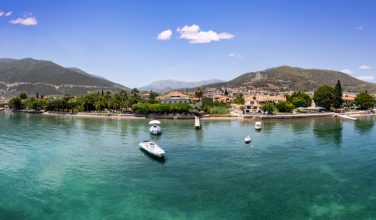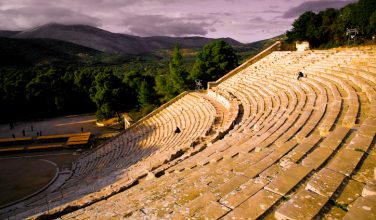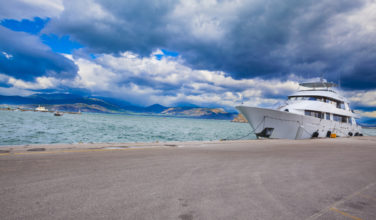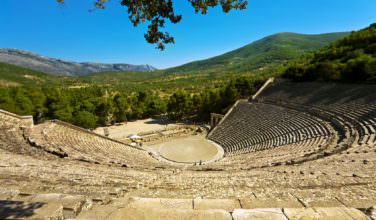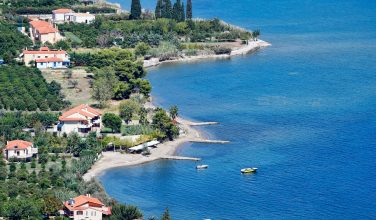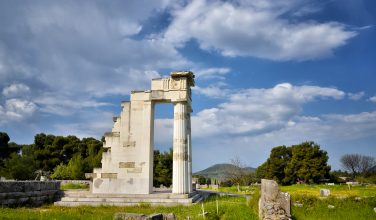Epidaurus is a small city in Greece on the northeastern side of Peloponnese. The region of Epidaurus is surrounded by greenery, mainly 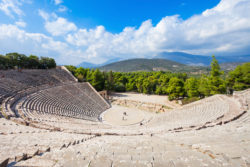 pine trees. The inland area of Epidaurus is also known for its lemon and orange trees. When making your way through the area, you will experience the rich aroma of the citrus trees.
pine trees. The inland area of Epidaurus is also known for its lemon and orange trees. When making your way through the area, you will experience the rich aroma of the citrus trees.
The name Epidaurus comes from the ancient theatre of Epidaurus located 15 km from the village.
According to Greek mythology, Epidaurus was the birthplace of Asklepios, the healing god and son of Apollo. The history of Epidaurus is closely connected to him. It is the home of one of the most popular healing centers in antiquity. In the 4th and 3rd century BC, the Romans would reconstruct the building and make it larger. The center was called the Asklepieion of Epidaurus and would attract sick people from all over Greece. Patients would have to stay at the facility to undergo treatment and take natural baths before heading back home. As a “thank you” to the god Asklepios, patients would make offerings and take part in games that took place every four years in the Stadium of Epidaurus. There would also be theatrical performances in the Ancient Theatre as part of religious festivities. Large earthquakes occurring in 522 AD and 551 AD would cause great damage to the sanctuary. It would be further destroyed by wars, natural disasters, and attacks. Many records made by the physicians of the Asklepieion are on display in museums around Greece.
After antiquity, Epidaurus would fall into decline. During the Middle Ages, a medieval castle was built in Nea Epidaurus village to protect the region from enemies. The early 19th century would see Epidaurus become important in politics when the first Greek revolutionary government was placed there and establish the first Greek constitution in 1822.
Administrative Region for Epidaurus, Greece
Peloponnese
Area of Epidaurus, Greece
Municipality: 340.4 km2 (131.4 sq mi)
Municipal Unit: 160.6 km2 (62.0 sq mi)
Population of Epidaurus, Greece
Municipality: 8,115
Municipal Unit: 3,887
Top Attractions in Epidaurus, Greece
The Ancient Theatre – In Ancient Greece, theatre was a big part of the culture. The theatre is part of an ancient sanctuary dedicated to the god Asclepius. The theatre was rediscovered in 1881 and parts of it have been restored.
Epidaurus Archaeological Museum – Located next to the Ancient Theatre. The museum houses findings from excavations in the area. Showcased are items including: coins, Classical and Roman statues, small statuettes, and more.
The Little Theatre – Located close to the village of Palia Epidaurus, amongst fruit trees. The Little Theatre was built from the 4th century BC until Hellenistic Times. Some of the seats have inscriptions showing the theatre was dedicated to the god Dionissos.
Sanctuary of Asklepios – Located next to the ancient theatre, this sanctuary was a healing center in ancient times. The sanctuary had sleeping rooms, a guesthouse with 160 rooms, a stadium, and mineral springs. Excavations in the 19th century revealed the Temple of Asclepius as well as ones dedicated to Apollo and Artemis.
Medieval Castle – On a hill above Nea Epidaurus. Explore the ruins of the Medieval Castle that was built during the 13th century by the Franks. One of three churches that stood inside the wall is still there today.
Kalamaki Beach – A pebbled and sandy beach with crystal clear water. This remote beach is surrounded by greenery. Kalamaki Beach can be reached by sea or by foot.
Vagonia Beach – Located behind the Church of St. Nicholas. This beach is surrounded by greenery and is considered a tranquil area. This beach can be accessed by sea, car, or on foot.
Monastery of Agnountos – This monastery was built in the 18th century though an exact date is unknown. The Byzantine architecture and art are beautiful. The interior of the church is covered with wall paintings.
Gliati Beach – A sandy beach with stones and clear water. There are places to eat on site, a restaurant and a cafe. The beach is located across from Panagitsa Beach.
Monastery of Taxiarches – Built in the 15th century, the monastery contributed to the Greek War of Independence. Since 1945, it is inhabited by nuns, not monks. The Monastery is open to visitors.


